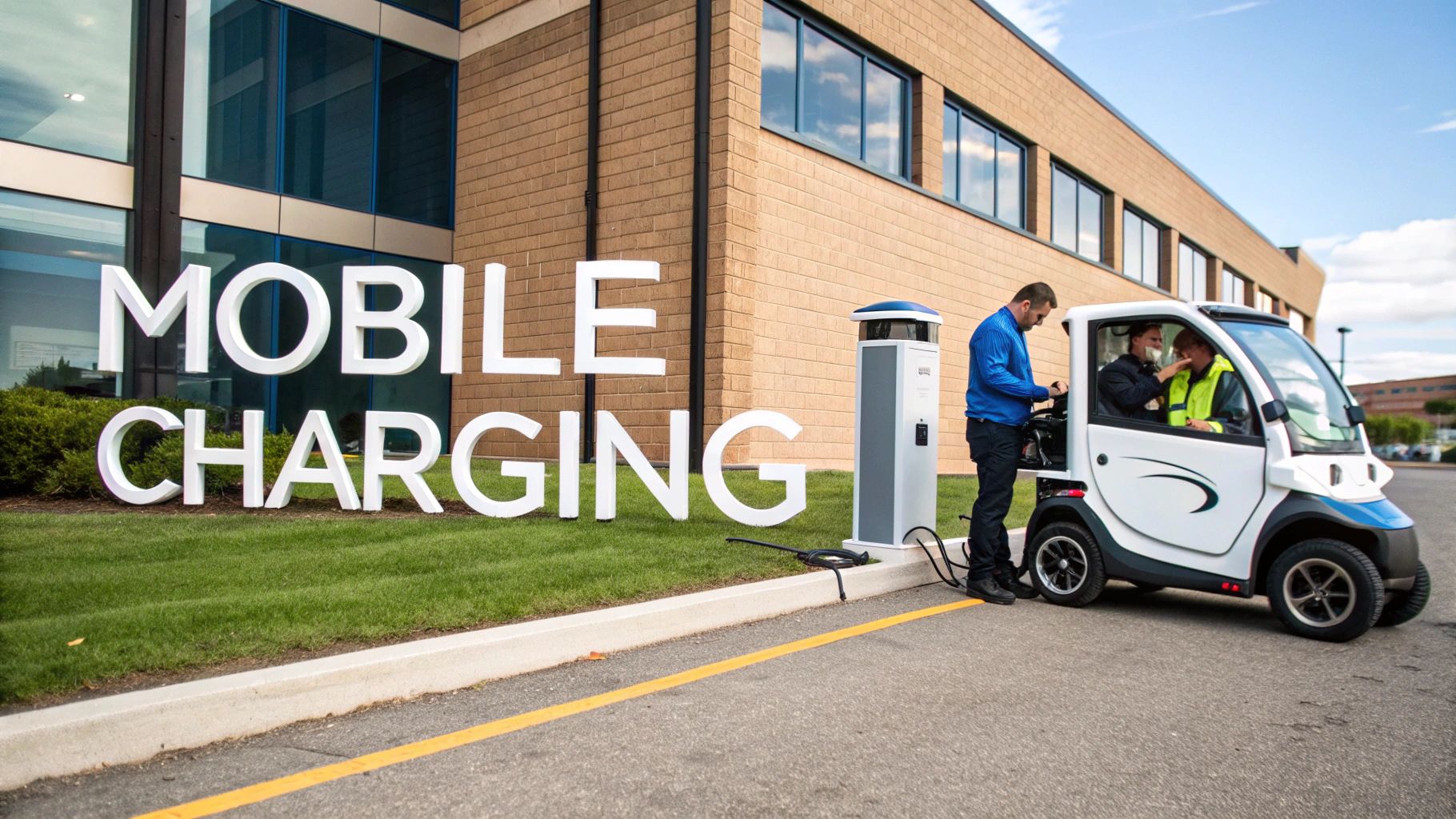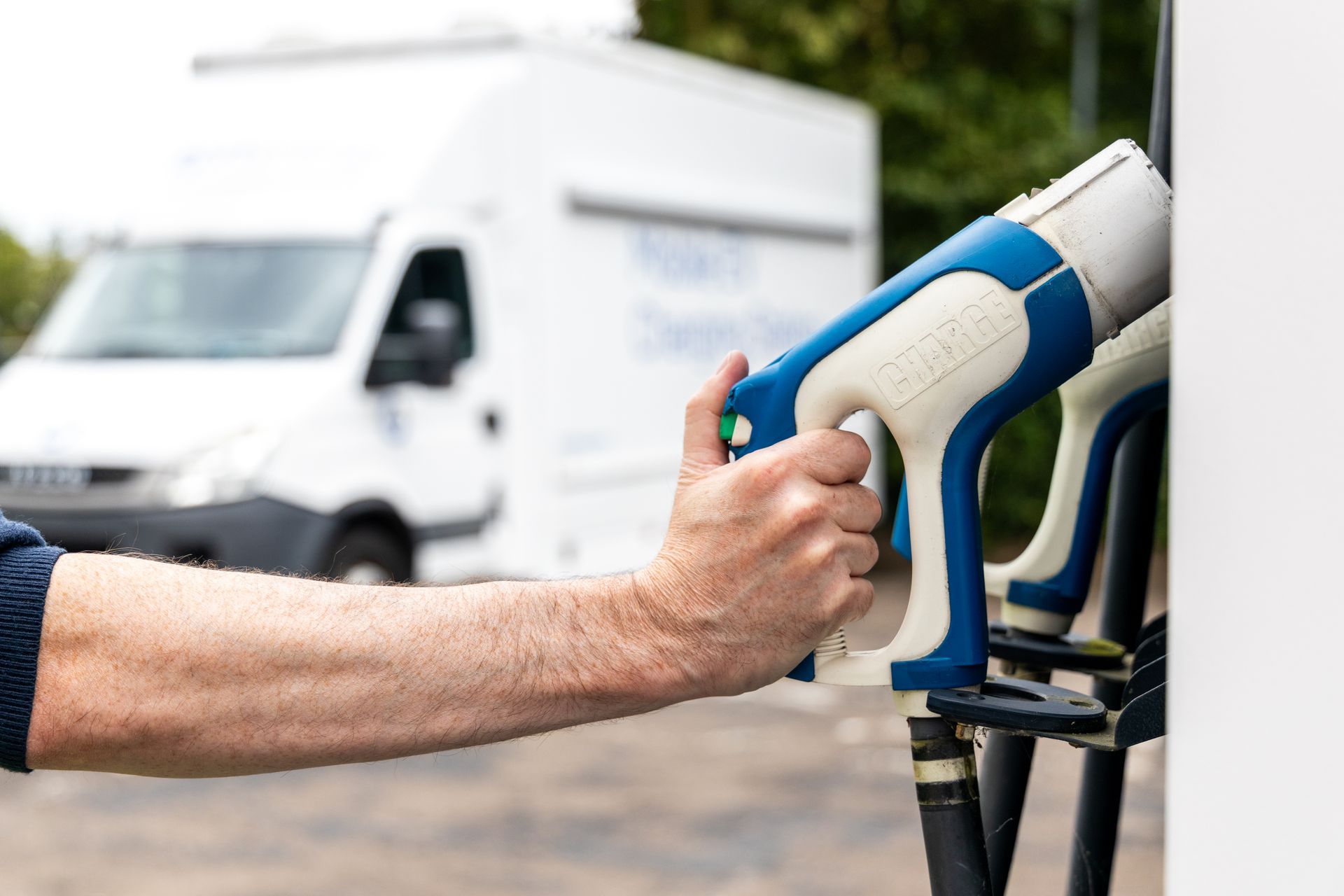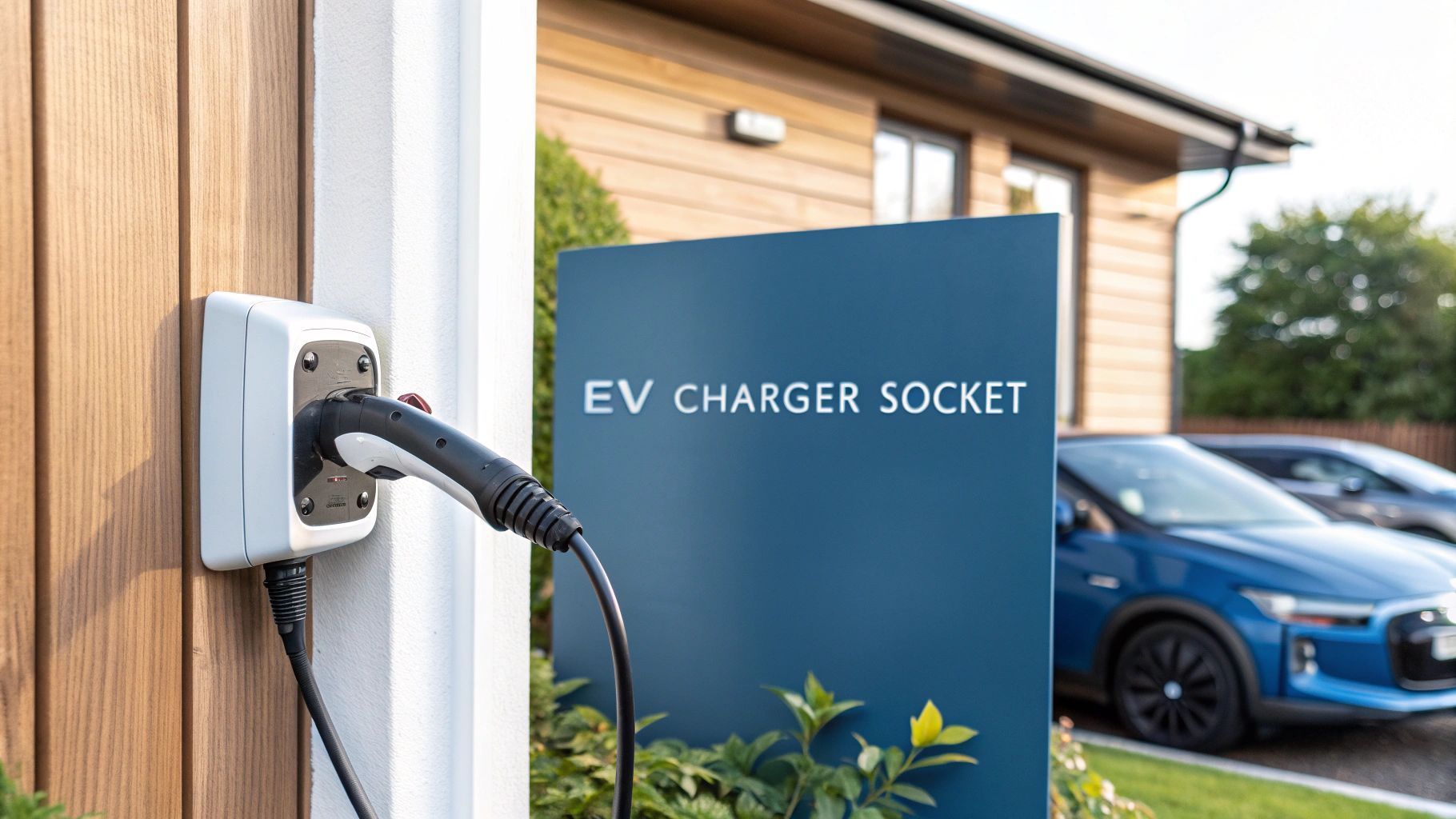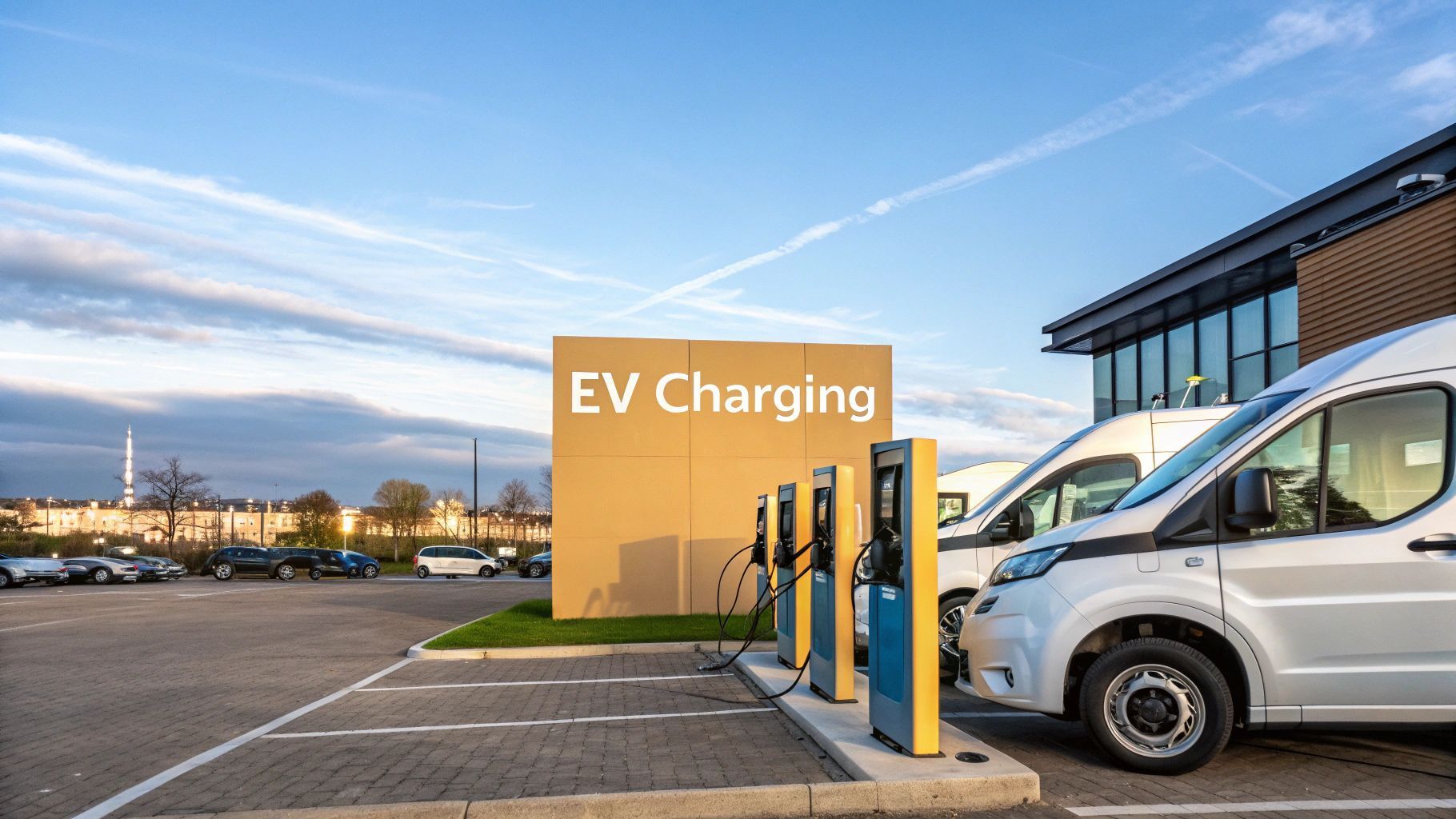Your Guide to Workplace EV Charger Schemes
Not long ago a workplace EV charger scheme was a nice-to-have perk. Now it's an essential asset for any forward-thinking business. It’s about more than just convenience for employees; it’s about embracing sustainability goals and seeing a tangible return on your investment, especially with flexible options like mobile charging.
Why Workplace EV Charging Is Now Essential
Putting a workplace EV charger on the company car park is no longer just a novelty; it’s a strategic move for UK businesses. As the country pushes towards its net-zero targets and drivers switch to electric vehicles in droves, the demand for reliable charging has skyrocketed. For many employees, particularly those who cannot charge at home, being able to top up their car at work is a game-changer.
But this shift is about more than just keeping staff happy. It is a powerful tool for business growth. Offering charging facilities shows a real commitment to sustainability and corporate responsibility, which does wonders for a company’s public image. It also acts as a compelling benefit in a tough job market, helping to attract and keep top talent who care about green credentials.
The Business Case for Workplace Charging
The benefits ripple out far beyond employee satisfaction. A well-planned workplace EV charging scheme can future-proof your entire operation. As more company fleets make the switch to electric, having chargers on-site becomes absolutely critical for keeping things running smoothly and cutting down on operational downtime.
So, what are the key drivers making workplace charging a must-have?
- Growing Employee Demand: After the home, the workplace is the most common place people charge their cars. That makes it a seriously valued employee benefit.
- Talent Attraction and Retention: A visible commitment to green tech makes your company a much more attractive place to work for both new hires and existing staff.
- Corporate Sustainability Goals: Installing chargers is a clear, measurable step that directly contributes to your ESG (Environmental, Social, and Governance) targets.
- Future-Proofing Your Fleet: For businesses moving their commercial vehicles to electric, on-site charging is vital to keep them on the road and working efficiently.
If you want to get your head around the basic concepts and the different types of chargers out there, it’s worth looking at some general EV charger information.
By integrating EV charging, businesses not only support the broader transition to clean transport but also unlock direct commercial advantages. This guide will explore how to plan, fund and implement a successful solution with a special focus on the flexibility and revenue potential of mobile EV charging.
The UK's workplace charging network has quickly become a vital piece of the country's electric vehicle puzzle. The Office for Zero Emission Vehicles (OZEV) runs the Workplace Charging Scheme (WCS), which has already helped fund thousands of charge points specifically for businesses. You can get more insights into UK EV charging trends with this detailed statistical overview.
Choosing the Right Charger for Your Business Needs
Picking the right workplace EV charger can feel like a daunting technical decision, but it’s simpler than you might think. Just imagine you’re filling a water bottle. You could use a slow-dripping tap, a steady-flowing kitchen tap or a high-pressure fire hose. Each one gets the job done but at vastly different speeds and costs.
EV chargers work on a similar principle, delivering power at different rates measured in kilowatts (kW). The trick is to match the 'tap' to the 'bottle'—or in this case, the charger speed to your specific business needs. A slow drip is perfect if you have all day, whereas a fire hose is essential if you need a full tank in minutes.
This infographic breaks down the key benefits that are driving businesses to install charging infrastructure.

As the decision tree shows, installing a workplace EV charger is about much more than just power; it supports talent attraction, helps you hit green objectives and gets your business ready for the future.
Slow Chargers: The All-Day Solution
Slow chargers, typically rated between 3 kW and 7 kW , are the most common and often the most practical choice for employee car parks. Think of these as the steady kitchen tap. An employee arriving at 9 a.m. and leaving at 5 p.m. has eight hours for their vehicle to charge, which is more than enough time for a 7 kW unit to provide a full charge for most EVs.
This makes them a fantastic, cost-effective solution. The installation is generally less demanding on your site's electrical supply and the hardware itself is more affordable. For staff who park all day, there’s really very little benefit to providing a much faster, and more expensive, charging option.
The UK’s public charging network reflects this practicality. Of the nearly 84,218 public EV charging devices, slow chargers make up the majority at 55% , with over 46,000 units installed. This represents a huge 43% increase from the previous year, proving their sustained importance for everyday charging. You can read more about the growth of different EV charger types to see the trend.
Fast Chargers: The Flexible Middle Ground
Fast chargers, which deliver between 8 kW and 49 kW , offer a significant step up in speed. These are ideal for workplaces with a more dynamic vehicle turnaround. For instance, they’re a great fit for fleet vehicles that return to base for a few hours between jobs or for visitors who need a meaningful top-up during a meeting.
The installation for these units is more involved and they require a more robust electrical supply—often a three-phase connection. However, their flexibility can be invaluable for business operations where vehicle availability is key.
While slower chargers serve the daily commuter perfectly well, fast chargers provide the operational agility needed for business fleets and high-turnover visitor parking. The choice really hinges on how your vehicles are used throughout the day.
Rapid Chargers: For When Speed Is Critical
At the top of the scale are rapid chargers, boasting power outputs of 50 kW and above . These are the fire hoses of the EV charging world, capable of adding hundreds of miles of range in under an hour. For most typical office environments, let's be honest, these are overkill and unnecessarily expensive.
However, for certain businesses, they are an absolute necessity. Logistics companies with electric vans, taxi firms or any operation where vehicle downtime directly translates to lost revenue can easily justify the significant investment. A rapid charger ensures a vehicle can get back on the road with minimal delay.
Comparing Workplace EV Charger Types
To help you visualise where your business might fit, this simple table compares the different charger types and their ideal use cases.
| Charger Type | Power Output (kW) | Typical Charging Time | Best Use Case for Your Workplace |
|---|---|---|---|
| Slow | 3-7 kW | 6-12 hours | Ideal for employees who are parked for the full workday. |
| Fast | 8-49 kW | 2-4 hours | Perfect for fleet vehicles, frequent visitors or staff on shorter shifts. |
| Rapid | 50kW+ | 20-60 minutes | Essential for business-critical vehicles that require immediate turnaround. |
Ultimately, choosing the right workplace EV charger comes down to taking a clear-eyed look at your daily operations. By understanding who needs to charge and for how long, you can select a solution that is both effective and economical for your business.
How to Fund Your Workplace Charger Installation
Figuring out the financial side of installing EV chargers at your workplace might seem daunting but there are clear routes to make it affordable and even profitable. From government grants that slash the initial outlay to clever models that generate revenue, funding your project is more accessible than you might think. The key is knowing what’s available here in the UK.
The best place for most UK businesses to start is the government's Workplace Charging Scheme (WCS) . It’s a voucher-based scheme run by the Office for Zero Emission Vehicles (OZEV), designed specifically to help organisations cover the upfront costs of buying and installing chargers.
This grant can dramatically lower the financial barrier to entry, making it an essential first step for any business looking to get a workplace EV charger project off the ground.
Understanding the OZEV Workplace Charging Scheme
The WCS gives eligible businesses a grant covering up to 75% of the total costs for the purchase and installation of EV charge points. This is capped at a maximum of £350 per socket . A single business can claim for up to 40 sockets across all its sites, which means you could get as much as £14,000 in government funding.
To get your hands on the grant, your business just needs to meet a few criteria:
- Be a registered business, charity or public sector organisation.
- Have dedicated off-street parking for your staff or fleet.
- Own the property or have the landlord's permission to install the chargers.
- Use an OZEV-approved installer to do the work.
The process is pretty straightforward. You apply for a digital voucher and then give it to your chosen installer. They handle the grant claim for you and simply knock the grant amount off your final bill. It’s a simple way to make that initial investment much more manageable. To budget properly, it's vital to get a real sense of the typical EV charger installation costs.
Beyond Grants: Exploring Other Financial Models
While the WCS grant is a fantastic start, it's not the only tool in your financial toolbox. Several other models can help you fund your installation and even turn your chargers into a new asset. These options offer flexibility and can be shaped to fit your business’s financial situation. Our guide on financing options for EV chargers dives into this in more detail.
Leasing is a popular alternative to buying the chargers outright. This lets you install the hardware with minimal upfront cash, paying a fixed monthly fee instead. These agreements often bundle in maintenance and support, giving you predictable costs and peace of mind.
Combining a government grant with other funding models creates a powerful financial strategy. It not only reduces your initial costs but also opens up pathways to generate a return on your investment over the long term.
Another smart strategy is to create a revenue stream from your chargers. By setting a competitive price per kWh for employees, visitors or even the public, you can cover your electricity costs and turn a profit. This works particularly well with mobile chargers, which can be moved to wherever demand is highest, maximising their earning potential.
Here in the UK, where electric vehicles made up 28% of new sales , this approach taps into a huge and growing market. With over half of UK BEV owners choosing their vehicle because of lower running costs, offering reliable workplace charging is a massive draw. You can discover more insights about UK EV adoption trends to see just how big the opportunity is.
The Rise of Mobile EV Charging for Business
When you think of workplace EV charging, you probably picture fixed units bolted to the ground in a car park. But what if you could have all that charging power without digging up the tarmac? A different approach is quickly gaining traction: mobile EV charging .
Imagine a powerful, self-contained charger on wheels, complete with its own energy source. You can move it exactly where you need it, whenever you need it. This simple but powerful concept completely changes the game for businesses looking to offer EV charging.
Instead of the huge commitment of installing permanent chargers, mobile units offer genuine flexibility. They are essentially powerhouses on wheels, from smaller units designed for a single car to large-scale batteries capable of charging an entire fleet. It’s an approach that neatly sidesteps many of the usual headaches and opens up significant revenue opportunities.

This adaptability is a game-changer. For businesses that lease their premises, operate across multiple sites or host temporary events, a mobile solution delivers charging capacity without the disruption and permanent commitment of major civil works.
Escaping the Hurdles of Fixed Installations
One of the biggest wins with a mobile workplace EV charger is dodging the serious cost and complexity of groundwork. Fixed chargers often mean digging trenches for armoured cables, paying for potential grid upgrades from your utility provider and sometimes even needing planning permission. These steps are not just expensive; they can bring your daily operations to a grinding halt.
Mobile chargers make these problems disappear. Because they’re self-powered and not physically tied to the grid at the point of use, there’s no need for costly electrical infrastructure work. The process is as simple as wheeling the unit into place, turning a months-long installation project into a job that takes just a few hours.
This gives you a much more dynamic and scalable way to provide charging. You could test demand in different spots around your car park before picking a permanent location or simply add more units as your team’s EV numbers grow. It puts you in control.
Turning Your Charger into a Profit Centre
Perhaps the most compelling reason for businesses to go mobile is the potential to generate substantial income. A fixed charger is often seen as just another overhead or an employee perk, but a mobile unit can be quickly turned into a profitable asset. Their mobility and self-contained design open up several commercial models that just aren’t possible with a fixed installation, allowing an operator to earn significant revenue.
This shifts the workplace EV charger from a simple amenity to an active part of your business's financial strategy. You're no longer just providing a service for your own staff; you're operating a flexible energy asset that can serve a much wider market.
With a mobile charger, you're not just buying a piece of hardware; you're investing in a versatile revenue-generating tool. It allows you to monetise your charging infrastructure in ways that are both creative and lucrative, turning a cost centre into a profit centre.
Exploring Your Revenue Models
So, how exactly can you make money from a mobile charger? The possibilities are surprisingly varied and can be tailored to fit your business, creating impressive profit margins.
- Pay-Per-Use Charging: The most direct route to profit. Offer charging to employees, visitors and even the general public on a pay-per-use basis. You set a competitive price per kilowatt-hour ( kWh ) that covers your costs and builds in a healthy profit margin on every session.
- Leasing to Other Businesses: Your mobile charger doesn’t have to stay put. You could lease it out to other local businesses, construction sites or event organisers who have a temporary need for EV charging but do not have their own setup. This creates a high-margin rental income.
- Fleet Charging Services: If you’re near an industrial park or other companies with electric fleets, you can offer your mobile charger as a dedicated charging solution for their vehicles during downtime. This creates a valuable B2B service and a steady, predictable income stream.
This commercial potential completely reframes the investment. A mobile workplace EV charger is not just about covering internal demand. It is about spotting a gap in the market for flexible charging in your local area and capitalising on it. By thinking like a service provider, you can create a reliable new income stream, turning an operational tool into a powerful financial asset. We will explore exactly how to forecast these earnings in the next section.
Forecasting Your Mobile Charger Earnings
Moving from the idea of a mobile workplace charger to a solid business case means we need to talk numbers. What kind of revenue can you actually expect? Let's walk through a practical example using a small UK business to make it tangible.
Picture a small tech firm with about 100 employees. Let’s imagine that 10% of them already drive electric vehicles. That gives you ten EV drivers on-site every day, creating an immediate and consistent demand for convenient charging.
Right there, you have a captive audience. The goal is to turn that demand into a reliable revenue stream by setting the right price and having a realistic idea of how often the charger will be used.
Setting Your Price and Estimating Usage
First things first, you need to decide what to charge. It’s all about finding that sweet spot—a price that’s competitive with local public chargers but still leaves a healthy profit margin for your business.
Let's assume the average commercial electricity rate is around 25p per kilowatt-hour (kWh) . You might decide to set your charging price at 50p per kWh . This simple pricing strategy instantly gives you a 100% markup on your main running cost: the electricity itself.
Next up is usage. How much energy will your team actually need? A typical EV driver arriving at the office might need a top-up of around 20 kWh to get them home and ready for the next day. With ten potential customers, it's pretty reasonable to plan for about five charging sessions a day.
This simple calculation is the bedrock of your financial forecast. By combining a competitive price per kWh with a realistic estimate of daily usage, you can begin to build a clear picture of your potential gross revenue.
With these figures in hand, we can start forecasting. If you provide five 20 kWh charges daily, you’re selling 100 kWh of energy. At 50p per kWh , that works out to £50 in gross revenue every single workday. Not a bad starting point at all.
Calculating Your Net Profit
Gross revenue is a great metric but it’s the net profit that really hits the bottom line. To figure that out, we just need to subtract your main operational cost—the electricity you’re selling.
Your mobile charger is dispensing 100 kWh a day. At a cost of 25p per kWh , your daily electricity expense comes to £25 .
Let’s break it down:
- Daily Gross Revenue: £50
- Daily Electricity Cost: £25
- Daily Net Profit: £25
From this straightforward pay-per-use model for your own staff, your business is generating an extra £25 in pure profit every day . That adds up to £125 per week , or around £500 per month . It’s a solid return from a single asset that also serves as a brilliant employee perk. For a deeper look, you can get more details on the economics of mobile EV charging models.
Example Weekly Revenue from a Mobile EV Charger
To give you a clearer picture, this table shows how weekly revenue can build up based on different usage scenarios. It illustrates the potential weekly income from a single mobile charging unit based on different usage scenarios and pricing models.
| Usage Scenario | Daily Charges | Average kWh per Charge | Price per kWh | Estimated Weekly Gross Revenue |
|---|---|---|---|---|
| Low Usage | 3 | 20 kWh | 50p | £150 |
| Medium Usage | 5 | 20 kWh | 50p | £250 |
| High Usage | 8 | 20 kWh | 50p | £400 |
Keep in mind, this example only covers charging for your own employees. The real power of a mobile charger lies in its flexibility. You could easily boost these earnings by leasing the unit out at weekends or offering charging services to neighbouring businesses, turning a handy internal tool into a genuinely profitable asset.
Getting Your Installation and Management Strategy Right
Putting a successful workplace EV charger scheme in place—whether it’s fixed or mobile—all comes down to good planning. A solid strategy makes sure your investment runs like clockwork from day one, serving both your employees and your business goals. This process starts long before a single piece of hardware shows up.
The first, and most critical, step is a proper site survey. This assessment is all about understanding your building's current electrical capacity and flagging any potential roadblocks. It tells you whether your existing supply can handle the extra demand from EV chargers or if you’ll need an upgrade—a major factor for your budget and timeline.

This survey also helps you pinpoint the best spots for the chargers themselves. You're looking for locations that are convenient for drivers but also make sense from an installation point of view, keeping cable runs as short and simple as possible.
Managing Your Charging Infrastructure
Once the chargers are installed, the focus shifts to smart management. Modern charging solutions are backed by intelligent software that gives you full command over your new setup. This is vital for balancing the electrical load, making sure the chargers don’t overwhelm your building's supply, especially when everyone plugs in at once.
This software also takes care of the money side of things. It lets you set charging prices, handle user accounts and process payments automatically. This turns your charging station into a self-sufficient system, which is essential if you plan on generating any revenue from it. To set a fair price, it helps to understand how to calculate a kilowatt-hour and what you’re paying for electricity in the first place.
A well-defined management plan is just as important as the physical installation. It transforms a collection of chargers into an efficient, reliable and potentially profitable business asset.
Establishing Clear Policies and Procedures
Finally, long-term success hinges on having clear ground rules and consistent upkeep. You’ll need to establish straightforward usage policies for your employees. These should cover everything from charging etiquette—like moving their car once it is full—to any time limits or costs involved.
Ongoing management also means putting a proactive maintenance schedule in place. Regular checks ensure your chargers stay safe, reliable and working as they should, preventing frustrating downtime for your team. By tackling these logistical and management steps upfront, you set your business up to run an efficient and effective workplace EV charger scheme from the get-go.
Got Questions About Workplace Charging?
When you start thinking about installing EV chargers at your workplace, a few practical questions naturally pop up. Getting these sorted can give you the confidence to move forward. From who pays for the power to how many chargers you’ll actually need, let's clear up some of the most common queries.
Practical and Financial Considerations
"Should we offer charging for free, or should employees pay?"
This is usually the first thing businesses ask and there's no single right answer—it all comes down to what you want to achieve. Offering free charging is a fantastic employee perk that can really boost morale and help you hold onto great staff. On the other hand, setting a small fee helps you recoup electricity and maintenance costs. Get the pricing right, and you could even turn it into a new revenue stream.
"How will installing chargers affect our building's electricity supply?"
A very important, and sensible, question. You’ll absolutely need a professional site survey to see what your current electrical system can handle. For many businesses, a few slow 7 kW chargers can be added without any major headaches. If you're looking at faster units, though, you might need to plan for more significant electrical work.
"What are the tax implications?"
Here’s some great news for UK businesses. When you let an employee charge their personal electric car at work, it’s not considered a taxable benefit in kind . This makes it a hugely tax-efficient perk to offer, benefiting both you and your team.
"What happens if more people buy EVs than we have chargers for?"
This is where a little bit of smart management goes a long way. Good software and clear rules are your best friends here. You can set up a simple booking system or create a fair use policy, like asking staff to move their car once it’s fully charged. The data you gather will also show you exactly when it's time to add more chargers—which is especially easy if you’re using flexible solutions like mobile units.
The main thing to remember is that nearly every potential hurdle has a straightforward, practical solution. A bit of planning, starting with a site survey and clear policies, will ensure your workplace charging scheme is a massive success.
Ready to explore a flexible, revenue-generating charging solution that avoids the cost and hassle of fixed installations? ZAPME offers pioneering mobile EV charging units designed for modern business needs. Discover how our adaptable technology can future-proof your workplace and create new income streams by visiting our ZAPME for business page.











